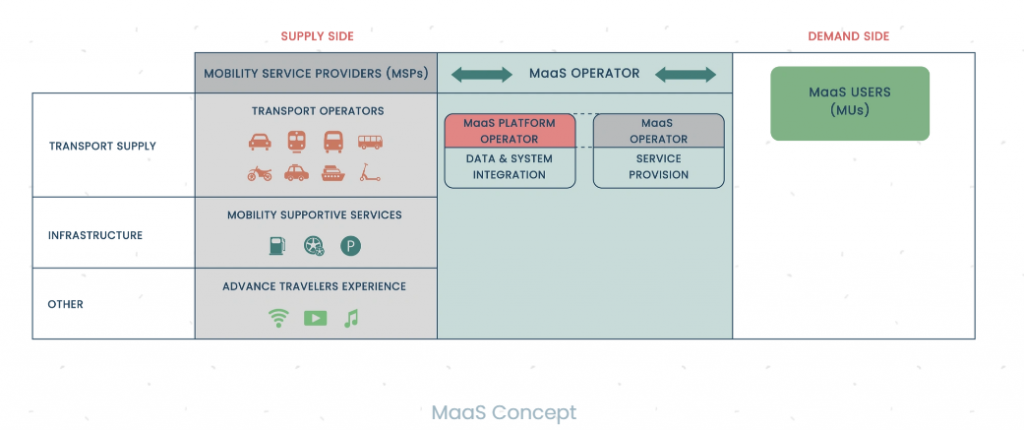Mobility as a Service (MaaS) is revolutionizing urban transportation by offering a comprehensive, user-centric approach to mobility.
What is MaaS?
There is currently no widely accepted definition of Mobility as a Service (MaaS), despite the considerable interest in the transportation industry from both the public and private sectors.
MaaSLab of the University College London defines it as follows.
MaaS – a user-centric, intelligent mobility management and distribution system, in which an integrator brings together offerings of multiple mobility service providers, and provides end-users access to them through a digital interface, allowing them to seamlessly plan and pay for mobility.

At its essence, Mobility as a Service (MaaS) revolves around the amalgamation of various services and the consolidated delivery of these services through a singular channel. Both intermediaries on the supply and demand sides are responsible for managing the integration and unified delivery of services.
In a precise sense, MaaS is focused on the integration aspect, uniting multiple mobility service providers into a cohesive and singular solution
MaaS Providers:
Various service providers contribute to Mobility as a Service (MaaS), encompassing transport companies that offer on-demand services, carpooling, and car-sharing. Shared mobility services, including ridesharing with companies like Uber and Lyft, as well as e-scooter and bike-sharing services, play a pivotal role in MaaS. Additionally, peer-to-peer rental services allow individuals to rent out their vehicles, providing a cost-effective alternative to conventional car rental services.
In instances where conventional public transportation falls short of meeting specific user needs, shared mobility and on-demand services can complement traditional options, potentially resolving the last-mile problem—the most expensive and time-consuming leg of the supply chain for deliveries.
Collectively, shared modes, public transportation, and emerging mobility alternatives form a comprehensive transportation network that can function as a supplement or substitute for private vehicles. While transport operators are typically viewed as primary suppliers, an increasing number of businesses are entering the MaaS market, including those offering entertainment services (such as Wi-Fi, movies, and games) and mobility-supportive services (like fuel providers, parking operators, highway services, and mobile phone charging), enhancing users’ overall travel experiences.
MaaS Platforms:
The MaaS platform comprises several interconnected components performing essential tasks such as data import, storage, trip planning, optimization, ticketing, payment, and communication. Users leverage these features to plan multimodal journeys, reserve transportation resources, receive on-route instructions, access rebooking recommendations in case of disruptions, and complete payments in a single transaction.
Key information provided by MaaS platforms includes the locations of public transportation stations, timetable and routing details, real-time locations of trains, buses, shared vehicles, and bikes, as well as availability and cost details for ride-hailing services. These platforms also outline reservation and payment methods for various transportation modes, contributing to a seamless and integrated user experience.

Opportunities & Challenges:
According to the Interreg Europe Programme, Mobility as a Service (MaaS) presents numerous potential advantages for mobility, including optimized networks for interoperability, improved information delivery, and heightened citizen efficiency. MaaS has the potential to reduce the necessity of car ownership, enabling more informed decisions about transportation modes based on specific circumstances. Consumers are empowered to easily choose the transportation product or combination that best aligns with their needs for each journey. Furthermore, MaaS considers users’ overall preferences for factors like comfort, speed, and cost, as well as route-specific needs such as carrying heavy luggage or ensuring accessibility—crucial for those with temporary or permanent mobility impairments. A comprehensive view of all transportation modes enhances the transparency of the true cost of mobility. A well-balanced mix of modes may offer cost-saving opportunities compared to private car ownership over time. For instance, the Ubigo MaaS project in Stockholm, as evaluated in a report, has garnered high satisfaction among users. They particularly appreciate the consolidated services, inclusive ticketing, and the ability to manage family trips under a single account.
In conclusion, MaaS not only streamlines transportation choices but also addresses diverse user needs, potentially transforming the way people perceive and utilize mobility services. Despite its promising advantages, the successful implementation of MaaS faces challenges such as technological integration, regulatory considerations, and widespread adoption, which necessitate careful navigation for its sustained growth and impact.
Source: Aristek Systems
